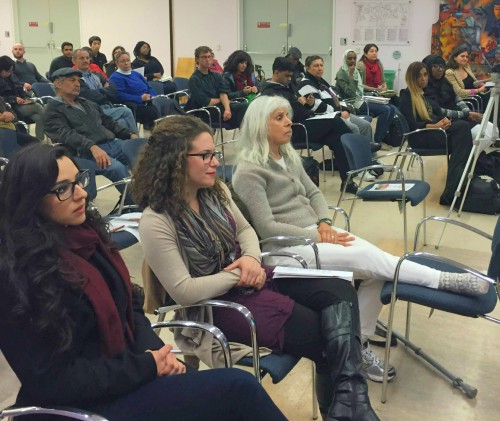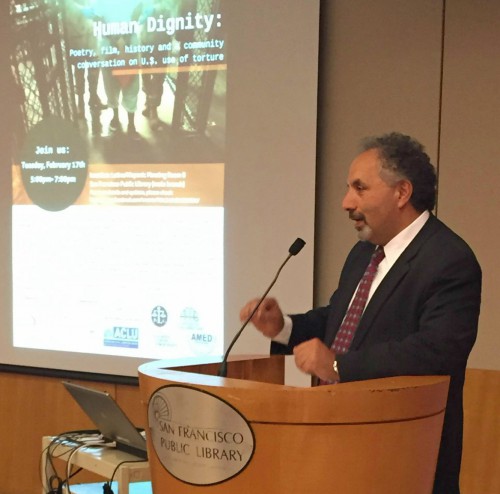By Reem Suleiman, Community Advocate National Security & Civil Rights
The government of Poland has recently announced it will comply with an order from the European Court of Human Rights to answer for its complicity in the CIA’s illegal rendition, torture, and detention programs by paying compensation to the victims. Yet, the U.S. has failed to hold government officials accountable for the widespread use of torture, now confirmed in the over 500-page redacted summary of an over 6,000-page report by the U.S. Senate Intelligence Committee. Advocates are still fighting to have the complete report released. Also, while the government of Canada has paid $8.9 million in compensation to U.S. torture victim Maher Arar, for its role, the U.S. has yet to offer any compensation to its torture victims, permit a civil lawsuit to move forward, or prosecute a single perpetrator.

Against this backdrop of U.S. impunity for torture, the Asian Law Caucus convened an event last week titled “Human Dignity: Poetry, film, history, and a community conversation on U.S. use of torture.” Our goal was to provide a space for a community conversation in the aftermath of the Senate Intelligence Committee’s summary report on torture by the U.S. government to help our community understand the contours of where we are and how we got here, and to inform the way forward as professionals, activists, organizers, and most importantly, as a community.
The event opened with a video excerpt from “Taxi to the Dark Side,” a documentary about an innocent Afghan taxi driver named Dilawar who was tortured to death in the U.S. military’s Bagram Prison. Spoken word artist Fatima Mekkoui performed moving poetry readings from “Poems from Guantanamo,” a collection of poems written by Guantanamo prisoners. During the subsequent community discussion, Mekkoui commented on how performing the detainees’ poems immersed her into their world, and was instrumental in processing the torture report–a sentiment echoed by several attendees.
Experts on international human rights and on treating torture survivors then gave testimony about the contours of the legal landscape and the healing process for torture survivors. Dr. Ghannam, Clinical Professor of Psychiatry and Global Health Sciences in the School of Medicine at UCSF, shared several reflections from his decades of experience working directly with tortured detainees. He commented on how both the recovery for victims and the accountability process for perpetrators are virtually nonexistent. Dr. Ghannam asserted that only through a community-centered approach and community engagement can victims move towards rehabilitation.

During a guided town hall discussion, the community in the room discussed a few questions relating to steps forward and how to build “community engagement.” Not surprisingly, our questions bred more questions–reflective of the lack of transparency and accountability from higher federal officials (not to mention the thousands of pages of the report that remain classified). During the discussion, a law student brought up parallels between Japanese-American internment and Guantanamo, noting that it took the U.S. over thirty years to acknowledge the wrongs of its past policies. Will it take that long for the U.S. to do so with the Arab Middle Eastern Muslim and South Asian communities, considering it has been nearly a decade and a half that largely AMEMSA communities have borne the brunt of U.S. torture programs? Another attendee made a critical connection between the mistreatment in U.S. prisons abroad and in the prisons in our neighborhoods. For example, several experts of international law argue that the use of solitary confinement–for even relatively short periods of time–is considered a form of torture, yet it is common for prisoners to be subjected to long periods of solitary confinement.
While much of the broader public discussion on the release of the redacted summary of the senate report has been centered on its effects on AMEMSA communities abroad, the implications are much more far-reaching than often discussed, and span to not only AMEMSA communities in the U.S. but to all communities in the U.S. and beyond as other countries look to U.S. practices and adopt them. In fact, the U.S.’ torture legacy is already finding its way home. The redacted summary of the Senate torture report reveals that the Federal Bureau of Prisons (BOP) paid a visit to COBALT, a dungeon-like CIA detention site nicknamed the “Dark Prison” and “Salt Pit”, in November 2002. A CIA officer noted that the BOP “had never been in a facility where individuals are so sensory deprived,” yet “they understood the mission and it was their collective assessment that in spite of all this sensory deprivation, the detainees were not being treated inhumanely.” The implications of this troubling rationale can be seen in the government expansion of Supermax prison facilities on American soil. Similarly, the Guardian reported just last week that a detective Richard Zuley implemented torture tactics from Guantanamo Bay on at least three people in Chicago state prison. Interestingly, Zuley was the officer responsible for interrogating Guantanamo detainee Mohamedou Ould Slahi, whose testimonial was read at the Human Dignity event by Hasmik Geghamyan, a member of the National Lawyers Guild-SF Bay Area.
The film, report readings, poetry, and expert commentary inspired a community discussion that proved to be a rich starting point for an ongoing discussion about how to move forward in calling for government transparency, and accountability.